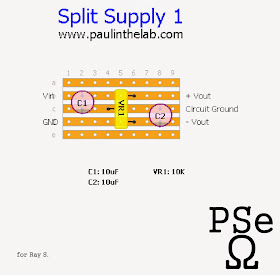a while ago I did a split supply circuit fragment which included a voltage follower
HERE - however there are much cheaper ways of achieving split supplies for experimentation with Op-Amps and other dual supply IC's (obviously this is for low power circuits eg guitar FX development etc.)
The
first example uses a Trim pot to divide the voltage which is pretty cool for biasing to favor either the positive or negative rail.
The
second example is the most common type of rail splitter - cheap as buggery and does its job. in the example I've given - it will divide the voltage in half so that if you put in 9 volts you get +4.5v and -4.5v
The
Third example uses Zener Diodes to give you a regulated split supply - however you do lose a volt or 2 so you need to supply them above their combined values.
eg if you use 2 5.1 volt diodes in the circuit provided - you need to supply it with 11 - 12 volts to get +5.1v and -5.1v
I shall include a table of Zener diode values at the bottom that I found in some datasheet a long time ago - unfortunately I am not sure where it came from because as usual I only saved the relevant page so if you stumble across this page and it's yours or you know whose it is - let me know so I can give you credit etc. I assume it's National Semiconductors though.

















